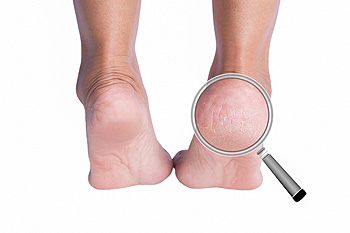
Although many cases of cracked heels are not necessarily severe and painful, the condition can nonetheless be an annoyance and potentially uncomfortable. The condition is defined as a lack of moisture on the back of the heels that causes the skin to crack and fissure. There are many ways in which cracked heels might be prevented. Socks might play an important role in achieving this end. For example, to prevent the heels from becoming dry, an individual could generously apply moisturizer to the feet at night before bed and put on a pair of socks. The socks can essentially lock in the moisturizer and help improve the extent to which the moisturizer is absorbed by the feet. If you are worried about cracked heels and want to learn more preventative methods, contact a podiatrist today. This foot specialist can help you address any problems you might have.
Cracked heels are unsightly and can cause further damage to your shoes and feet. If you have any concerns, contact one of our podiatrists from Lovely Foot Associates, PC. Our doctors can provide the care you need to keep you pain-free and on your feet.
Cracked Heels
Cracked heels appear unappealing and can make it harder for you walk around in sandals. Aside from looking unpleasant, cracked heels can also tear stockings, socks, and wear out your shoes. There are several methods to help restore a cracked heel and prevent further damage.
How Do You Get Them?
Dry skin is the number one culprit in creating cracked heels. Many athletes, walkers, joggers, and even swimmers suffer from cracked heels. Age and skin oil production play a role to getting cracked heels as well.
Promote Healing
Over the counter medicines can help, especially for those that need instant relief or who suffer from chronic dry feet.
Wear Socks – Wearing socks with medicated creams helps lock in moisture.
Moisturizers – Applying both day and night will help alleviate dryness which causes cracking.
Pumice Stones – These exfoliate and remove dead skin, which allows for smoother moisturizer application and better absorption into the skin.
Change in Diet
Eating healthy with a well-balanced diet will give the skin a fresh and radiant look. Your body responds to the kinds of food you ingest. Omega-3 fatty acids and zinc supplements can also revitalize skin tissue.
Most importantly, seek professional help if unsure how to proceed in treating cracked heels. A podiatrist will help you with any questions or information needed.
If you have any questions, please feel free to contact our office located in Johnstown, PA . We offer the newest diagnostic and treatment technologies for all your foot care needs.
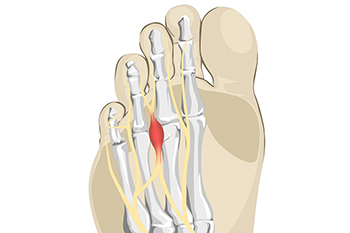
An inflamed nerve found between the third and fourth toes is indicative of Morton’s neuroma. It is a benign condition, despite it causing severe pain and discomfort. This condition is often caused by wearing shoes that do not have enough room for the toes to move freely in. Women who frequently wear high heels may be afflicted with Morton’s neuroma and medical attention is often sought for pain relief. The pain comes from an irritated nerve that gradually becomes compressed, which can affect the entire foot. There may be existing medical conditions that lead to the development of Morton's neuroma. These can consist of bunions, hammertoes, or arch abnormalities. Additionally, participating in running and jumping sporting activities may put pressure on the ball of the foot, resulting in this type of neuroma. If you have pain in this area of your foot, please schedule an appointment with a podiatrist who can effectively diagnose and treat Morton’s neuroma.
Morton’s neuroma is a very uncomfortable condition to live with. If you think you have Morton’s neuroma, contact one of our podiatrists of Lovely Foot Associates, PC. Our doctors will attend to all of your foot care needs and answer any of your related questions.
Morton’s Neuroma
Morton's neuroma is a painful foot condition that commonly affects the areas between the second and third or third and fourth toe, although other areas of the foot are also susceptible. Morton’s neuroma is caused by an inflamed nerve in the foot that is being squeezed and aggravated by surrounding bones.
What Increases the Chances of Having Morton’s Neuroma?
Morton’s neuroma is a very treatable condition. Orthotics and shoe inserts can often be used to alleviate the pain on the forefront of the feet. In more severe cases, corticosteroids can also be prescribed. In order to figure out the best treatment for your neuroma, it’s recommended to seek the care of a podiatrist who can diagnose your condition and provide different treatment options.
If you have any questions, please feel free to contact our office located in Johnstown, PA . We offer the newest diagnostic and treatment technologies for all your foot care needs.

The way the foot meets the ground differs in walking and running. Generally, the heel touches the ground first and the weight then rolls onto the ball of the foot and toes during walking. In fact, studies show that walking onto the ball of the foot takes about 50 percent more energy and walking on the toes takes about 80 percent more energy. Heel-first walking is considered to be the most economical way to move. However, this economy of movement does not necessarily transfer to running, some believe. Studies have shown that it is more efficient to land on the toes or ball of the foot while running, rather than on the heel first. In fact, the fastest runners in the animal kingdom – horses, gazelles, deer, and dogs – all land on their toes first. Many elite human runners, both sprinters and distance, do not land on their heels first. That said, many experts agree that your natural strike pattern, toe first or heel first, should remain constant, as it is less efficient to try to convert from one to the other. For more information on the effects of walking or running on your feet, please consult a podiatrist.
If you have any concerns about your feet, contact one of our podiatrists from Lovely Foot Associates, PC. Our doctors can provide the care you need to keep you pain-free and on your feet.
Biomechanics in Podiatry
Podiatric biomechanics is a particular sector of specialty podiatry with licensed practitioners who are trained to diagnose and treat conditions affecting the foot, ankle and lower leg. Biomechanics deals with the forces that act against the body, causing an interference with the biological structures. It focuses on the movement of the ankle, the foot and the forces that interact with them.
A History of Biomechanics
Modern technological improvements are based on past theories and therapeutic processes that provide a better understanding of podiatric concepts for biomechanics. Computers can provide accurate information about the forces and patterns of the feet and lower legs.
Understanding biomechanics of the feet can help improve and eliminate pain, stopping further stress to the foot.
If you have any questions please feel free to contact our office located in Johnstown, PA . We offer the newest diagnostic and treatment technologies for all your foot and ankle needs.
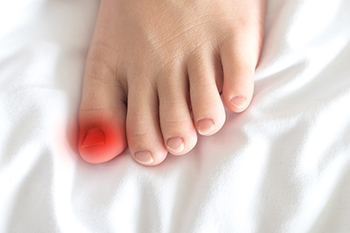
Most people misunderstand the seriousness of an ingrown toenail unless they experience one. Ingrown toenails frequently affect the big toe and result from the nail growing into the skin, instead of over it. Pain and discomfort are often the beginning signs that an ingrown toenail has developed. When left untreated, it may become infected, bleed, and there may be discharge or pus. An ingrown toenail can be caused by trimming the toenails incorrectly, wearing shoes that are too tight, and genetic reasons. Occasionally, the toe will feel better when soaked in warm water and a cotton swab can be used to gently push the skin away from the nail. This is a temporary fix for mild relief. A permanent solution can be found at a podiatrist's office. People who have recurring ingrown toenails often seek the expertise of this type of doctor, who can effectively treat it. An infected ingrown toenail may qualify for surgery, and it is suggested that you contact a podiatrist to determine the best course of treatment for you.
Ingrown toenails can become painful if they are not treated properly. For more information about ingrown toenails, contact one of our podiatrists of Lovely Foot Associates, PC. Our doctors can provide the care you need to keep you pain-free and on your feet.
Ingrown Toenails
Ingrown toenails occur when a toenail grows sideways into the bed of the nail, causing pain, swelling, and possibly infection.
Causes
Prevention
Because ingrown toenails are not something found outside of shoe-wearing cultures, going barefoot as often as possible will decrease the likeliness of developing ingrown toenails. Wearing proper fitting shoes and using proper cutting techniques will also help decrease your risk of developing ingrown toenails.
Treatment
Ingrown toenails are a very treatable foot condition. In minor cases, soaking the affected area in salt or antibacterial soaps will not only help with the ingrown nail itself, but also help prevent any infections from occurring. In more severe cases, surgery is an option. In either case, speaking to your podiatrist about this condition will help you get a better understanding of specific treatment options that are right for you.
If you have any questions please feel free to contact our office located in Johnstown, PA . We offer the newest diagnostic and treatment technologies for all your foot and ankle needs.
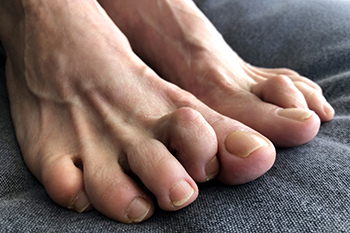
A hammertoe is a type of toe deformity that affects the smaller toes, causing the joint to form a peak in the middle instead of lying flat. This peak then rubs against the inside of a shoe, causing pressure that results in pain. The longer you wait to address the issue of a hammertoe, the worse it gets and the more difficult it is to correct. In the early stages, the toe joint may still be flexible. Non-surgical treatment, such as wearing a protective pad or changing the type of shoes worn, can often keep the pain at bay. However, as the hammertoe progresses, the joint becomes more rigid and may require surgery to correct it. Hammertoe is usually caused by an imbalance in the muscle and tendon that leads to the bending of the toe. A hammertoe can be made worse by wearing shoes that do not fit properly or that force the toes into a cramped position. Sometimes a hammertoe is hereditary or caused by trauma. For more information about how to get relief from a hammertoe, please consult a podiatrist.
Hammertoes can be a painful condition to live with. For more information, contact one of our podiatrists of Lovely Foot Associates, PC. Our doctors will answer any of your foot- and ankle-related questions.
Hammertoe
Hammertoe is a foot deformity that occurs due to an imbalance in the muscles, tendons, or ligaments that normally hold the toe straight. It can be caused by the type of shoes you wear, your foot structure, trauma, and certain disease processes.
Symptoms
Risk Factors
Treatment
If you have hammertoe, you should change into a more comfortable shoe that provides enough room for your toes. Exercises such as picking up marbles may strengthen and stretch your toe muscles. Nevertheless, it is important to seek assistance from a podiatrist in order to determine the severity of your hammertoe and see which treatment option will work best for you.
If you have any questions, please feel free to contact our office located in Johnstown, PA . We offer the newest diagnostic and treatment technologies for all your foot care needs.
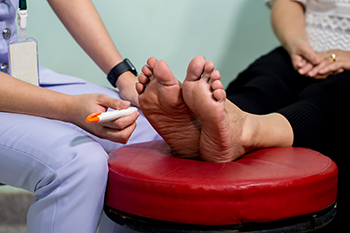
The nerves of the body send signals to its parts in the periphery, such as the feet. A diabetic who has developed nerve damage from long-term high blood sugar levels may have a side effect known as neuropathy. This results in a lack of feeling in the feet, which may cause other harmful side effects. Some risk factors that can cause neuropathy include overconsumption of alcohol, imbalance in vitamin B levels, and certain medications. Among the symptoms of diabetic nerve damage are prickling, tingling, and burning sensations. In addition, someone with diabetic neuropathy may experience sharp, shooting pain that feels like being pricked by a needle. If you have nerve damage in your feet, you may also be at risk of developing ulcers from sores, cuts, or wounds that go undetected due to numbness. Although there is no cure yet for diabetic neuropathy, several treatments are available to reduce its effects. For additional help, please consult with a podiatrist who is trained in how to handle this type of condition.
Neuropathy
Neuropathy can be a potentially serious condition, especially if it is left undiagnosed. If you have any concerns that you may be experiencing nerve loss in your feet, consult with one of our podiatrists from Lovely Foot Associates, PC. Our doctors will assess your condition and provide you with quality foot and ankle treatment for neuropathy.
What Is Neuropathy?
Neuropathy is a condition that leads to damage to the nerves in the body. Peripheral neuropathy, or neuropathy that affects your peripheral nervous system, usually occurs in the feet. Neuropathy can be triggered by a number of different causes. Such causes include diabetes, infections, cancers, disorders, and toxic substances.
Symptoms of Neuropathy Include:
Those with diabetes are at serious risk due to being unable to feel an ulcer on their feet. Diabetics usually also suffer from poor blood circulation. This can lead to the wound not healing, infections occurring, and the limb may have to be amputated.
Treatment
To treat neuropathy in the foot, podiatrists will first diagnose the cause of the neuropathy. Figuring out the underlying cause of the neuropathy will allow the podiatrist to prescribe the best treatment, whether it be caused by diabetes, toxic substance exposure, infection, etc. If the nerve has not died, then it’s possible that sensation may be able to return to the foot.
Pain medication may be issued for pain. Electrical nerve stimulation can be used to stimulate nerves. If the neuropathy is caused from pressure on the nerves, then surgery may be necessary.
If you have any questions, please feel free to contact our office located in Johnstown, PA . We offer the newest diagnostic and treatment technologies for all your foot care needs.
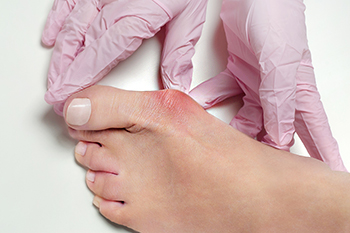
There are many deformities that can inhibit your daily activities, cause pain, and affect all or part of the foot. Among the most common foot deformities are bunions, hammertoe, flat feet and high arches, claw toe, and clubfoot. Foot deformities are sometimes caused by lifestyle choices, such as wearing shoes that do not fit properly. Wearing high heels for long periods can result in bunions, as well as pain in the ball of the foot. Shoes with narrow and pointed toe boxes may also contribute to the formation of hammertoes, as well as other toe deformities, like claw toes. Other causes of deformities are injury and genetics. Additionally, foot deformities may be the result of underlying medical conditions, including several types of arthritis and diabetes. Rheumatoid arthritis, which is an autoimmune disease, often results in bony formations and distortions in the bones of the feet. Some foot deformities, such as clubfoot, are congenital. In many cases, this deformity can be corrected if treated early in the child’s life. Slightly deformed feet may sometimes be corrected with special bracing or custom orthotics. More severe deformities may require surgery. If you have questions about a deformity of your foot, please consult a podiatrist.
Foot Pain
Foot pain can be extremely painful and debilitating. If you have a foot pain, consult with one of our podiatrists from Lovely Foot Associates, PC. Our doctors will assess your condition and provide you with quality foot and ankle treatment.
Causes
Foot pain is a very broad condition that could be caused by one or more ailments. The most common include:
Diagnosis
To figure out the cause of foot pain, podiatrists utilize several different methods. This can range from simple visual inspections and sensation tests to X-rays and MRI scans. Prior medical history, family medical history, and any recent physical traumatic events will all be taken into consideration for a proper diagnosis.
Treatment
Treatment depends upon the cause of the foot pain. Whether it is resting, staying off the foot, or having surgery; podiatrists have a number of treatment options available for foot pain.
If you have any questions, please feel free to contact our office located in Johnstown, PA . We offer the newest diagnostic and treatment technologies for all your foot care needs.
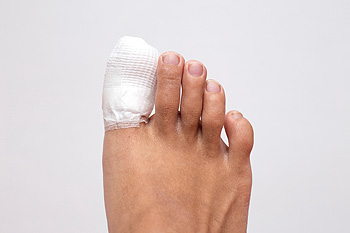
A broken, or fractured, toe can cause a patient pain, swelling, or even prolonged bruising. If you have broken your toe, there are several things you should be on the lookout for that might indicate you ought to seek immediate medical attention. Generally speaking, severe toe fractures require prompt professional attention. Severe fractures are those that involve open wounds, the big toe, or suddenly crooked toes. Additionally, some severe symptoms might indicate that you ought to see a doctor. For example, if you notice any sensations of numbness, visible red streaks around the affected toe, or bleeding, it is wise to see a podiatrist immediately. Also, if you find that you have developed a fever after you have broken your toe, this is another reason to make an appointment. It is best to err on the side of caution and let a medical professional, such as a podiatrist, examine your condition.
A broken toe can be very painful and lead to complications if not properly fixed. If you have any concerns about your feet, contact one of our podiatrists from Lovely Foot Associates, PC. Our doctors will treat your foot and ankle needs.
What to Know About a Broken Toe
Although most people try to avoid foot trauma such as banging, stubbing, or dropping heavy objects on their feet, the unfortunate fact is that it is a common occurrence. Given the fact that toes are positioned in front of the feet, they typically sustain the brunt of such trauma. When trauma occurs to a toe, the result can be a painful break (fracture).
Symptoms of a Broken Toe
Generally, it is best to stay off of the injured toe with the affected foot elevated.
Severe toe fractures may be treated with a splint, cast, and in some cases, minor surgery. Due to its position and the pressure it endures with daily activity, future complications can occur if the big toe is not properly treated.
If you have any questions please feel free to contact our office located in Johnstown, PA . We offer the newest diagnostic and treatment technologies for all your foot and ankle needs.